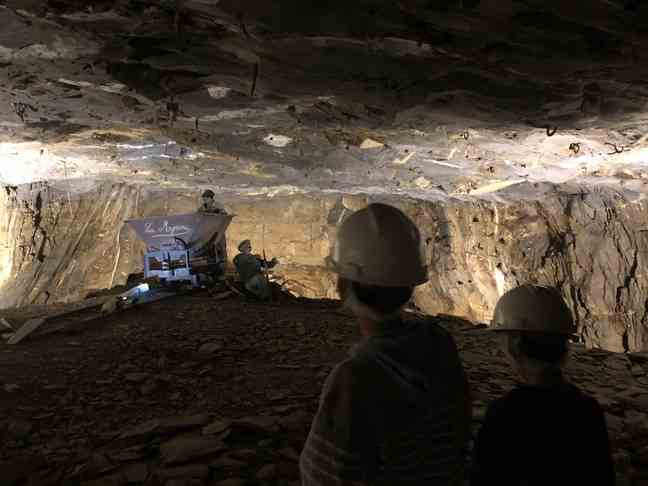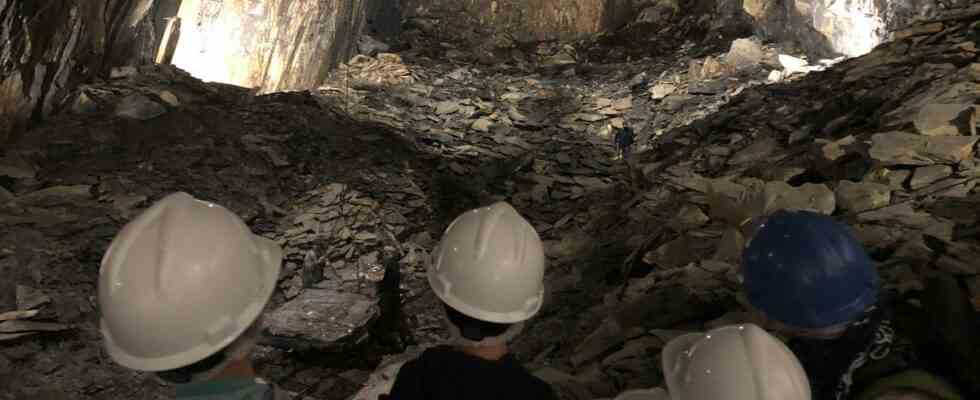Our descent, in the elevator, only lasted a minute. But you have to imagine that those who worked there for twenty years, at the beginning of the 20th century, would sink for more than half an hour to reach the end of the 813 irregular and slippery steps. It was there, 126 meters underground and at 13 degrees in both summer and winter, that the hundred or so “basket guys”, as they called themselves, were busy six days a week, by the light of their lamps. oil. Welcome to the Gâtelière slate quarry, called the blue mine since it became a tourist site in the 1990s. Located in Noyant-la-Gravoyère (Maine-et-Loire), it was visited by 35,000 visitors of all ages in 2019.
In this unique place in Europe, mine in operation from 1916 to 1936 before the bank that held it went bankrupt, the immersion is total and immediate. Equipped with a helmet (and a fleece jacket), we first find the humid atmosphere of a cave before being immersed in the very special world of slate, which has made the reputation and the identity of blue Anjou. Crammed into an authentic mine train (it shakes, but not like at Disney), we then travel a few hundred of the 4,000 meters of galleries, which led to the 26 extraction chambers of this famous blue rock with a flaky appearance. The machine slows down and two honks sound: everyone descends.
The harsh daily life of miners
If some adjustments (lighting and the addition of a few mannequins in particular) have been made since the closure, the strength of the visit is that “most of what you see there was left by our miners as is”, explains Rose, our guide. And we cannot say that they were unemployed. On the walls several tens of meters high, you have to look up to see holes, made with a “hand drill”, which a colleague then filled in to explode the rock. With a hammer at first, then with a drill as heavy as it was noisy, other miners were then tasked with separating these “lost” pieces into blocks, of a maximum of five tons. “They were particularly exposed to dust, the number one enemy of miners,” continues Rose. Despite their mustache, which they thought was a natural filter, their life expectancy did not exceed 45 years due to schistosis. »
Because beyond the know-how, it is the harsh daily life of the miners (and the donkeys who helped them to pull up the loaded winches) that we discover along this astonishing course. “It’s not a spectacle, abounds Bénédicte Flamand, the director of the Blue Mine. We show the state of mind, the history of what is our heritage, as faithfully as possible. Even mentioning the recipe for La Postillonne, the famous alcoholic drink consumed by mine employees to give themselves courage. If you want to test, it was made up of eau-de-vie at 60°, wine, sugar and coffee…

Above, the splitters
An hour and a half later, we are happy to breathe fresh air again, even if it is 15 degrees warmer outside. Under a marquee, this time we discover the work of the “top guys”, who bought the material directly at the exit and spent twelve hours on site, with their backs bent, cutting very thin slate blades. These splitters and their apprentices, some of whom were only 12 years old, could take out 600 pieces a day, intended to garnish the roofs of the surrounding area and beyond.
At the time, the region had several slate mines of this type. The last, in Trélazéclosed in 2014. If there are still quarries in France, in Corrèze in particular, it is Spain which is today the largest producer.

